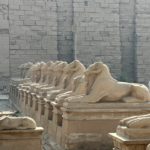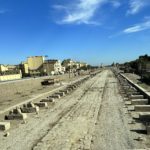withoutdoors An optional balloon ride over the Valley of the Kings was offered – but it required leaving the ship at 5:00 AM – just a few days after we finally adjusted to the time changes. The day broke pretty hazy, since the wind was very light. We decided to pass.

Râs el Aïoun Sphinx
Today, we explored the Karnak Temple complex. Said to be the world’s largest religious structure in area (162 acres), the vast Karnak Temple complex was built and used over a period of 2,000 years. At the heart of the immense complex is the Temple Amun, dedicated to the king of gods, Amun-Re, who was also the god of war and his wife, Mut, the goddess of motherhood, and their son, Khonsu, god of the moon. With its endless courts, halls, and colossi and huge sacred lake, the scale and complexity of this complex could be overwhelming. A row of sphinx’s create a walkway to the Nile. The temple’s exterior walls are covered with reliefs showing military scenes. The interior walls are carved with scenes of offerings.. Colossus of Ramses II, an imposing granite statue of Ramses II with one of his daughters at his feet, stands in front of the entrance to The Great Hypostyle Hall, where a monolithic forest of 134 huge columns is laid out in 16 rows. The largest are 33 feet around and soar to 80 feet in height. The hall has the basics of basilica architecture with a central hallway higher then its two side corridors.
From its modest 11th dynasty beginnings, pharaoh after pharaoh added to and changed the existing buildings, seeking to leave their mark on the country’s most important temple. No expense was spared and during the 19th dynasty some 80,000 men worked as laborers, guards, priests, and servants. The temple was buried by drifting sand for 1,000 years before excavation began in the mid 19th century. Restoration is ongoing. The Great Festival Temple, behind the Great Hypostyle Hall was built by Tuthmosis II and was designed to resemble the tent he lived in while on his campaign in Syria. The Botanic Gardens, part of the temple built by Tuthmosis II, is a roofless enclosure decorated with bas reliefs of exotic flora and fauna he brought back to Egypt from Syria. The Sacred Lake is where priests cleansed themselves with its holy water before performing rituals in the temples. North of the lake is a huge stone scarab of Khepri built by Amenhotep III.
A walkway lined with rams-head sphinxes leads all the way from the Karnak complex to the 3,500-year-old Luxor Temple complex, we had visited a few days ago.
On the way back to the ship, we stopped at a papyrus factory, learned how papyrus paper is made from pieces of papyrus stem and visited a gallery where items were for sale. Mike videoed the talk about how papyrus paper is made.
The rest of the day was free-time: to have lunch, to pack to fly to Cairo and then go on to Alexandria, to sit in the sun on the roof deck, or just relax.
After dinner this evening, we were treated to a belly-dancing show on board ship. Famed for its controlled and precise movements, this gyrating art form is said to have originated in Cairo’s nightclubs before graduating to the silver screen. We were also visited by a whirling dervish.































